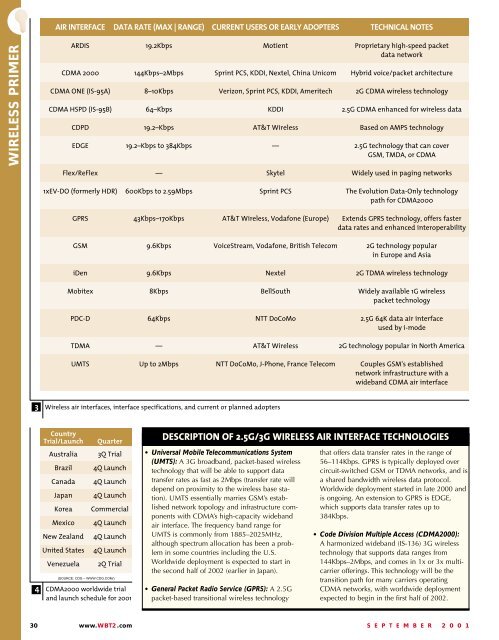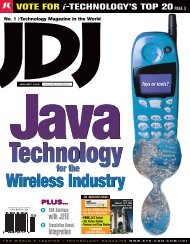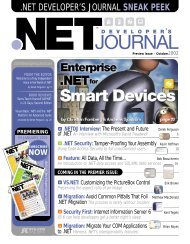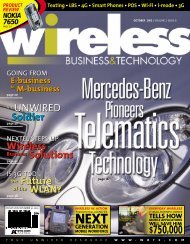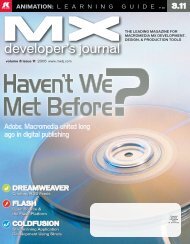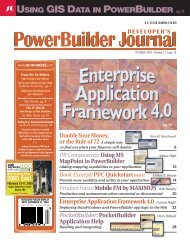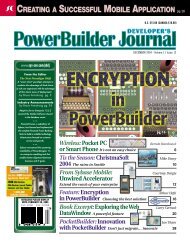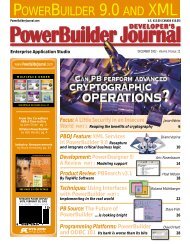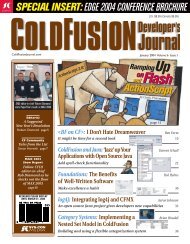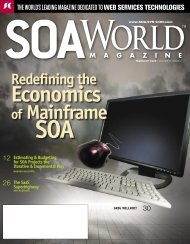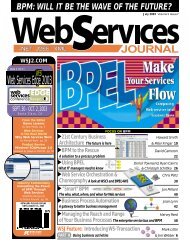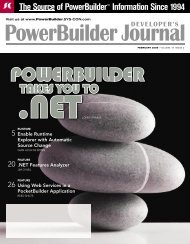wireless primer - sys-con.com's archive of magazines - SYS-CON ...
wireless primer - sys-con.com's archive of magazines - SYS-CON ...
wireless primer - sys-con.com's archive of magazines - SYS-CON ...
You also want an ePaper? Increase the reach of your titles
YUMPU automatically turns print PDFs into web optimized ePapers that Google loves.
WIRELESS PRIMER<br />
AIR INTERFACE DATA RATE (MAX | RANGE) CURRENT USERS OR EARLY ADOPTERS TECHNICAL NOTES<br />
ARDIS 19.2Kbps Motient Proprietary high-speed packet<br />
data network<br />
CDMA 2000 144Kbps–2Mbps Sprint PCS, KDDI, Nextel, China Unicom Hybrid voice/packet architecture<br />
CDMA ONE (IS-95A) 8–10Kbps Verizon, Sprint PCS, KDDI, Ameritech 2G CDMA <strong>wireless</strong> technology<br />
CDMA HSPD (IS-95B) 64–Kbps KDDI 2.5G CDMA enhanced for <strong>wireless</strong> data<br />
CDPD 19.2–Kbps AT&T Wireless Based on AMPS technology<br />
EDGE 19.2–Kbps to 384Kbps — 2.5G technology that can cover<br />
GSM, TMDA, or CDMA<br />
Flex/ReFlex — Skytel Widely used in paging networks<br />
1xEV-DO (formerly HDR) 600Kbps to 2.59Mbps Sprint PCS The Evolution Data-Only technology<br />
path for CDMA2000<br />
GPRS 43Kbps–170Kbps AT&T Wireless, Vodafone (Europe) Extends GPRS technology, <strong>of</strong>fers faster<br />
data rates and enhanced interoperability<br />
GSM 9.6Kbps VoiceStream, Vodafone, British Telecom 2G technology popular<br />
in Europe and Asia<br />
iDen 9.6Kbps Nextel 2G TDMA <strong>wireless</strong> technology<br />
Mobitex 8Kbps BellSouth Widely available 1G <strong>wireless</strong><br />
packet technology<br />
PDC-D 64Kbps NTT DoCoMo 2.5G 64K data air interface<br />
used by i-mode<br />
TDMA — AT&T Wireless 2G technology popular in North America<br />
UMTS Up to 2Mbps NTT DoCoMo, J-Phone, France Telecom Couples GSM's established<br />
network infrastructure with a<br />
wideband CDMA air interface<br />
3 Wireless air interfaces, interface specifications, and current or planned adopters<br />
Country<br />
Trial/Launch Quarter<br />
Australia 3Q Trial<br />
Brazil 4Q Launch<br />
Canada 4Q Launch<br />
Japan 4Q Launch<br />
Korea Commercial<br />
Mexico 4Q Launch<br />
New Zealand 4Q Launch<br />
United States 4Q Launch<br />
Venezuela 2Q Trial<br />
(SOURCE: CDG – WWW.CDG.COM/)<br />
4 CDMA2000 worldwide trial<br />
and launch schedule for 2001<br />
DESCRIPTION OF 2.5G/3G WIRELESS AIR INTERFACE TECHNOLOGIES<br />
• Universal Mobile Telecommunications System<br />
(UMTS): A 3G broadband, packet-based <strong>wireless</strong><br />
technology that will be able to support data<br />
transfer rates as fast as 2Mbps (transfer rate will<br />
depend on proximity to the <strong>wireless</strong> base station).<br />
UMTS essentially marries GSM’s established<br />
network topology and infrastructure components<br />
with CDMA’s high-capacity wideband<br />
air interface. The frequency band range for<br />
UMTS is commonly from 1885–2025MHz,<br />
although spectrum allocation has been a problem<br />
in some countries including the U.S.<br />
Worldwide deployment is expected to start in<br />
the se<strong>con</strong>d half <strong>of</strong> 2002 (earlier in Japan).<br />
• General Packet Radio Service (GPRS): A 2.5G<br />
packet-based transitional <strong>wireless</strong> technology<br />
that <strong>of</strong>fers data transfer rates in the range <strong>of</strong><br />
56–114Kbps. GPRS is typically deployed over<br />
circuit-switched GSM or TDMA networks, and is<br />
a shared bandwidth <strong>wireless</strong> data protocol.<br />
Worldwide deployment started in late 2000 and<br />
is ongoing. An extension to GPRS is EDGE,<br />
which supports data transfer rates up to<br />
384Kbps.<br />
• Code Division Multiple Access (CDMA2000):<br />
A harmonized wideband (IS-136) 3G <strong>wireless</strong><br />
technology that supports data ranges from<br />
144Kbps–2Mbps, and comes in 1x or 3x multicarrier<br />
<strong>of</strong>ferings. This technology will be the<br />
transition path for many carriers operating<br />
CDMA networks, with worldwide deployment<br />
expected to begin in the first half <strong>of</strong> 2002.<br />
30 www.WBT2.com S E P T E M B E R 2 0 0 1


